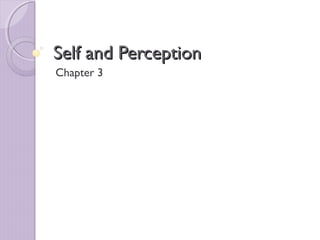Com120 03 perception_13ed-1
•Télécharger en tant que PPT, PDF•
1 j'aime•467 vues
Signaler
Partager
Signaler
Partager

Recommandé
Contenu connexe
Tendances
Tendances (13)
Emotions: Applications in Organisational Behaviour

Emotions: Applications in Organisational Behaviour
Interpersonal Communication 1 - Emotional Intelligence

Interpersonal Communication 1 - Emotional Intelligence
Emotional Intelligence in the Workplace: Mentoring Others to Success

Emotional Intelligence in the Workplace: Mentoring Others to Success
Similaire à Com120 03 perception_13ed-1
Similaire à Com120 03 perception_13ed-1 (20)
Communication and Perception Communicating in the Real World .docx

Communication and Perception Communicating in the Real World .docx
Communication and Perception Communicating in the Real World .docx

Communication and Perception Communicating in the Real World .docx
Communication and Perception Communicating in the Real World .docx

Communication and Perception Communicating in the Real World .docx
Plus de turnercom
Plus de turnercom (20)
Com120 03 perception_13ed-1
- 2. Topics Self Concept Self Awareness Stages of perception “Impression Formation processes” ◦ Barriers to effective perception Increasing accuracy in perception
- 3. Self Concept How you see yourself
- 4. Sources of Self Concept Others’ images of you Social comparison Cultural teachings Your interpretations and evaluations
- 5. Self Awareness The extent to which you know yourself Johari Model ◦ Open self ◦ Blind self ◦ Hidden self ◦ Unknown self
- 6. Self Esteem What is Self Esteem? Ways to improve self-esteem
- 7. Increasing Self Awareness Ask yourself Listen to others Seek information See your different selves Increase your open self
- 9. Perception Stages Stimulation Organization Interpretation / Evaluation Memory Recall
- 10. 1. Stimulation Sensing stage Selective Perception: Cannot process everything in the environment ◦ Selective Attention ◦ Selective Exposure
- 11. 2. Organization Organize information sensed Rules ◦ Proximity ◦ Similarity ◦ Contrast Schemata Scripts – Schema focused on an event
- 12. 3. Interpretation Give meaning to what you have sensed Meaning will be based on how information was organized
- 13. 4. Memory Experiencewill enter our memory based on how we have interpreted the event.
- 14. 5. Recall Remembering the event later Recall will be consistent with previous stages May add or subtract information to fit our expectations (rules, schema)
- 15. “Impression Formation Processes” Self-fulfilling Prophecy Implicit Personality Theory Perceptual Accentuation Primacy vs Recency Consistency Attribution of Control
- 16. Self-fulfilling prophecy: ◦ We make predictions about our communication outcomes ◦ However, we also influence those outcomes with our behaviors ◦ We then use this outcome to “prove our point”
- 17. Implicit Personality Theory: ◦ We use observations of others to draw conclusions ◦ (Similar to stereotyping, but based on personality traits, not group identity)
- 18. Perceptual Accentuation ◦ We perceive what we expect (or want) to observe instead of what actually occurs
- 19. Primacy vs Recency ◦ First impressions strongly influence later interactions ◦ More recent impressions may cause us to reinterpret our perception
- 20. Consistency ◦ We expect consistency in events and relationships
- 21. Attribution: ◦ Our attempts to determine motivation for behaviors Errors: ◦ Self-serving Bias ◦ Overattribution ◦ Fundamental Attribution Error
- 22. Increasing Accuracy Perception checking ◦ Describe what you observe What did you see / hear? Concrete terms ◦ Ask for confirmation of your perception Do not tell, ASK